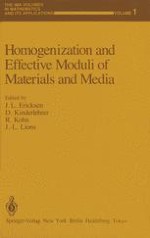This IMA Volume in Mathematics and its Applications Homogenization and Effective Moduli of Materials and Media represents the proceedings of a workshop which was an integral part of the 19R4-R5 IMA program on CONTINUUM PHYSICS AND PARTIAL DIFFERENTIAL EQUATIONS. We are grateful to the Scientific Committee: J . L. Ericksen D. Kinderlehrer H. Brezis C. Dafermos for their dedication and hard work in rleveloping an imaginative, stimulating, and productive year-long program. George R. Sell Hans Weinherger PREFACE The papers in this volume were presented at a workshop on homogenization of differential equations and the determination of effective moduli of materials and media, primarily in the context of continuum theory. These areas are closely linked to a variety of phenomena, such as the elastic and dielectric responses of composites, and the effective properties of shales and soils. For instance, the ability to predict the effective stiffness response of a composite across a broad range of frequencies allows its performance under given circumstances to be assessed by means of nondestructive testing. A fundamental mathematical tool is homogenization, the study of partial differential equations with rapidly varying coefficients or boundary conditions. The recent alliance of homogenization with optimal design has stimulated the development of both fields. The presentations at the workshop emphasized recent advances and open questions.
